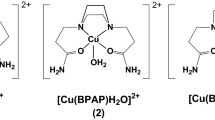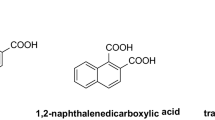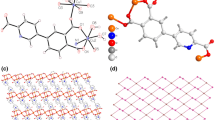Abstract
The cytotoxic activity of the polymer–copper(II) complex, [Cu(bpy)2(BPEI)]Cl2·4H2O (bpy = 2,2′-bipyridine, BPEI = branched polyethyleneimine) on NCI-H460 human lung cancer cells was determined adopting MTT assay and specific staining techniques. Many of the cultured NCI-H460 cancer cells treated with this complex suffered loss of viability and death mostly through apoptosis and/or necrosis as evidenced by the changes in the nuclear morphology and cytoplasmic features.





Similar content being viewed by others
References
Brabec V, Kasparkova J, Vrana O, Novakova O, Cox JW, Qu Y, Farrell N (1999) DNA modifications by a novel bifunctional trinuclear platinum phase I anticancer agent. Biochemistry 38:6781–6790
Domb A, Amselem S, Shah J, Maniar M (1992) Degradable polymers for site-specific drug delivery. Polym Adv Technol 3:279–292
Elmore S (2007) Apoptosis: a review of programmed cell death. Toxicol Pathol 35:495–516
Fontes APS, Bandarage R, Farrell N, Yun Q, Rauter H, Kelland LR (2000) Synthesis, characterization, and cytotoxicity of trifunctional dinuclear platinum complexes: comparison of effects of geometry and polyfunctionality on biological activity. J Med Chem 43:3189–3192
Go RS, Adjei AA (1999) Review of the comparative pharmacology and clinical activity of cisplatin and carboplatin. J Clin Oncol 17:409–422
Grodzinski JJ (2006) Polymers for tissue engineering, medical devices, and regenerative medicine. Concise general review of recent studies. Polym Advan Technol 17:395–418
Kasibhatla H, Finucane D, Brunner T, Wetzel EB, Green DR (2000) Cell: a laboratory manual. Protocol: staining of suspension cells with Hoechst 33258 to detect apoptosis, vol 1. Cold Spring Harbor Laboratory Press, New York, pp. 15.5–15.7
Levin S, Bucci TJ, Cohen SM, Fix AS, Hardisty JF, LeGrand EK, Maronpot RR, Trump BF (1999) The nomenclature of cell death: recommendations of an ad hoc committee of the Society of Toxicologic Pathologists. Toxicol Pathol 27:484–490
Morley M, Finger PT, Perlin M, Weiselberg LR, DeBlasio DS (1991) Cis-platinum chemotherapy for ocular basal cell carcinoma. Br J Ophthalmol 75:407–410
Mosmann T (1983) Rapid colorimetric assay for cellular growth and survival: application to proliferation and cytotoxicity assays. J Immunol Methods 65:55–63
Pelicano H, Carney D, Huang P (2004) ROS stress in cancer cells and therapeutic implications. Drug Resist Updates 7:97–110
Perego P, Gatti L, Caserini C, Supino R, Colangelo D, Leone R, Spinelli S, Farell N, Zunino F (1999) The cellular basis of the efficacy of the trinuclear platinum complex BBR 3464 against cisplatin-resistant cells. J Inorg Biochem 77:59–64
Proskuryakov SY, Konoplyannikov AG, Gabai VL (2003) Necrosis: a specific form of programmed cell death? Exp Cell Res 283:1–16
Putnam D, Kopecek J (1995) Polymer conjugates with anticancer activity. Adv Polym Sci 122:55–123
Ricci MS, Zong WX (2006) Chemotherapeutic approaches for targeting cell death pathways. Oncologist 11:342–357
Senthil Kumar R, Sasikala K, Arunachalam S (2008) DNA interaction of some polymer–copper(II) complexes containing the 2, 2′-bipyridyl ligand and their antimicrobial activities. J Inorg Biochem 102:234–241
Spector DL, Goldman RD, Leinwand LA (1998) Cell: a laboratory manual. culture and biochemical analysis of cells, vol 1. Cold Spring Harbor Laboratory Press, New York, pp 34.1–34.9
Wong E, Giandomenico CM (1999) Current status of platinum-based antitumor drugs. Chem Rev 99:2451–2466
Acknowledgements
The DST-FIST and UGC-SAP support for improvement of infrastructure facility at Animal Science Department of Bharathidasan University, and the UGC-SAP, COSIST, and DST-FIST programmes offered to the School of Chemistry are gratefully acknowledged.
Author information
Authors and Affiliations
Corresponding author
Rights and permissions
About this article
Cite this article
Senthil Kumar, R., Periasamy, V.S., Preethy Paul, C. et al. Cytotoxic effect of a polymer–copper(II) complex containing 2,2′-bipyridyl ligand on human lung cancer cells. Med Chem Res 20, 726–731 (2011). https://doi.org/10.1007/s00044-010-9380-8
Received:
Accepted:
Published:
Issue Date:
DOI: https://doi.org/10.1007/s00044-010-9380-8




